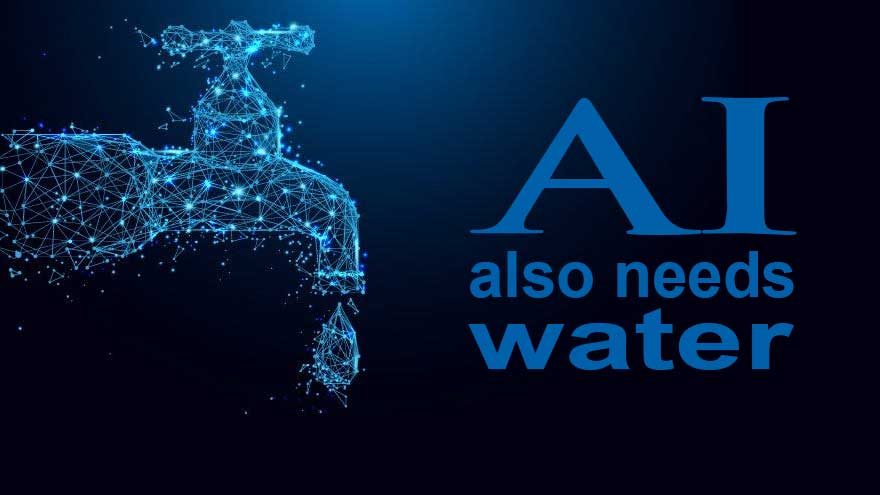ChatGPT is being discussed continuously. This is a platform where you can ask anything. A recent study about ChatGPT, which has become very popular within a short time, is scary. According to this, the chatbot drinks water during every 20 to 50 questions. Even during training, it is swallowing 7 lakh liters of water.

No, AI does not consume water in the way living organisms do. AI is a digital technology that runs on computer hardware and software, and it does not require any physical resources to function, such as water or food. However, the hardware that runs AI systems may require cooling, and the cooling systems may use water for this purpose. Additionally, the manufacturing and disposal of hardware can have an impact on the environment and water resources. But in terms of AI itself, it does not consume water.
While solving difficult papers in an exam or giving a speech on stage, we gulp down water to keep our brain cool and functioning properly. This is exactly what happens with artificial intelligence as well. During answering queries or completing a task, it gets heated up. In such cases, water is used to keep the data center cool. This is done in several ways, and it varies depending on the size of the data center and the weather conditions. However, it is certain that it is enough to drain the entire water source.
The amount of water consumed by the hardware running an AI system can vary depending on the specific system and the cooling technology used. In general, water consumption by cooling systems is primarily dependent on the efficiency of the cooling technology, the ambient temperature of the environment where the system is running, and the workload of the system.
Many data centers that house AI hardware use water-based cooling systems, which can be more efficient than air-based cooling systems in terms of energy consumption. However, water consumption can vary widely depending on the specific technology used and the efficiency of the cooling system. Some estimates suggest that water usage in data centers can range from less than 1 liter per kWh to more than 10 liters per kWh, with an average of around 2-3 liters per kWh.
It's worth noting that the water usage of AI hardware is only a small fraction of the total water consumption in most industrialized countries. Agriculture, industry, and residential water use typically far exceed the water usage of data centers and other computing infrastructure.
As an AI language model, ChatGPT runs on computer servers maintained by OpenAI, the organization that developed and operates the model. The exact water consumption of the hardware running ChatGPT is not publicly available, as it likely depends on several factors, such as the specific type of hardware and cooling system used, the efficiency of the data center's cooling infrastructure, and the location and climate of the data center.
However, OpenAI has stated that it is committed to reducing the environmental impact of its AI systems, and it has implemented various measures to improve energy efficiency and reduce carbon emissions. OpenAI's hardware infrastructure is hosted on cloud providers, such as Microsoft Azure and Amazon Web Services, which are also taking steps to reduce their environmental impact.
Overall, while the exact water consumption of the hardware running ChatGPT is not known, it is likely a small fraction of the total water consumption associated with computing infrastructure globally, and organizations like OpenAI and its cloud providers are actively working to reduce the environmental impact of their operations.
Google has been asked for a long time through its search engine how much water its data centers consume. The answer to this question was found in 2021. In that year alone, Google consumed 6.3 billion gallons of water in the United States. Meanwhile, this consumption was one billion gallons worldwide. Five years ago, in 2017, this water consumption was three billion gallons annually. This report was released by Google itself.
Every minute, millions or even more people ask and understand something from Google, which increases the load on the servers. At that time, data centers use water to cool themselves.
Experts from the University of Texas Arlington and University of Colorado Riverside estimated how much water ChatGPT might consume. According to a paper titled "Making AI Less Thirsty," the water footprint of this open AI is quite substantial. During training alone, GPT-3 uses more than 700,000 liters of water. This is as much water as is needed to make 70 BMW cars, or enough water to cool a nuclear reactor.
Different data centers consume different amounts of water, but there is no definite information on how much water is consumed by centers of what capacity. Some studies suggest that even a small 1-megawatt center consumes approximately 25.5 million liters of water annually. This consumption varies depending on the weather. Data centers usually consume less water in the winter months and more in the summer months.
Hyper-scale data centers consume the most water. They are quite large, such as Google, which runs hyper-scale data for features such as Gmail, Google Drive, and Google Photos. According to Digital Infrastructure, in 2021, Google's average data center consumed 4.5 lakh gallons of water per day. There are also smaller data centers that are consuming water.
Microsoft and Amazon's data centers are also consuming a significant amount of water to keep themselves running. After much controversy, Microsoft has set a goal of becoming water-positive by 2030. It claims that within the next 7 years, its centers will use only water that is not suitable for drinking or irrigation. Similarly, Amazon Web Services has identified a total of 20 data centers in the world, where it has started using recycled water.